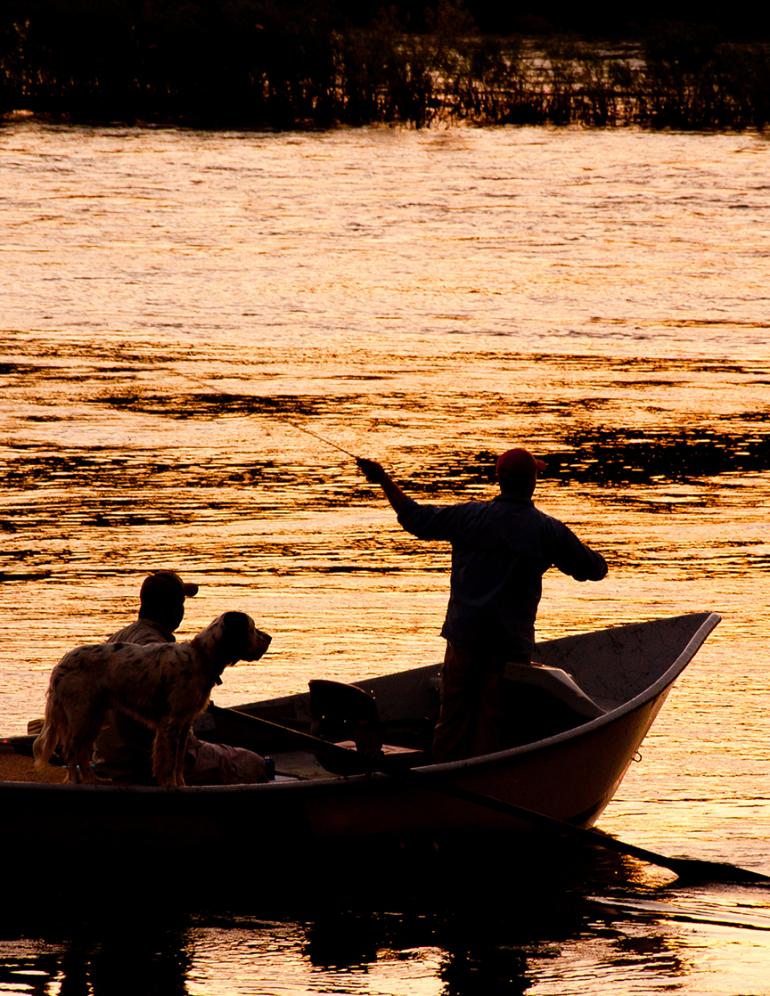Captain Canine
Fishing with dogs.
I’ve always been something of an outdoors schizophrenic. This does not mean a crazy person who lives outside. Nor does this imply that I only go nuts when I’m out of the house. No, what I am is a person who has too many interests to fit into a lifetime and most of those interests are spent in wild country. Finding time to enjoy as many of those interests as possible—and still hold down a job that pays for it all—leaves one a tad bit tired, if not a little insane. Fly fishing, boating, canoeing, bird and big-game hunting, telemark skiing, horsepacking, backpacking. Only one lifetime.
Some of these activities fit together seamlessly. Canoeing and fishing are two perfect examples. Other activities just don’t belong in the same drift boat. There are many times when I feel that taking dogs along on a fishing trip is that kind of ill-fitting hat.
True, if you hunt birds and also enjoy fly fishing, there are some real advantages. Having a dog to point partridges comes in handy when one uses their skins for fly tying. But actually taking that dog fly fishing can be a bit more problematic.
After many years spent trying to marry these two unlikely partners, I’ve boiled my “taking dogs fishing” philosophy down to a couple of quick caveats. Take the right dog. Go by yourself unless your dog is extremely well-trained. Take a dog that really doesn’t like water. And leave him at home if you are serious about catching fish.
Taking the right dog is critical. Several years ago, I decided to step out and buy a drift boat. I’d wanted one for years, and one doesn’t get by in a state like Montana without some kind of watercraft. When a good boat came up for sale, a friend and I jumped on it. The first trip, we floated an easy stretch of river with another friend who knew his way around oar-powered craft. Neither of the new owners knew a thing, but with a little coaching, we felt like pros after one trip.
That next day came with just the two of us and no coach. We decided to tackle the Upper Madison, which is one long, boulder-strewn riffle. For a skilled boater, the river is one of the finest in the country. For the tender, it’s a nightmare. I brought my two English setters: Ike, a big male, and Sage, an energetic female.
Thankfully, not many people were out to see the ridiculous events of that day. My friend took the oars first and we pivoted out into the stream, spun a 360, and slammed into a big boulder. Ike immediately went to the bottom of the boat in a quivering, wet bundle of nerves. Sage hopped to the bow and watched geese fly over. We slammed into another rock. Ike tried to crawl under the oarsman’s seat. We slammed into a larger rock, spun in another 360, and my usually-unsullied friend unleashed a string of obscenities that would make Andrew Dice Clay blush. Sage wagged her tail from the bow and watched the water for rising trout. Ike trembled. On that day, Sage became my boat dog. I’ve gotten a whole lot better at the sticks, and nowadays when I take the drift boat, Ike stays home and Sage is queen of her own ship.
Which brings me to my second point: make sure your dog is really well-trained if you insist on taking him or her fishing. Not long after that harrowing journey on the Madison, Sage joined another friend and me on a much milder river, and I actually hooked a medium-sized rainbow from the boat.
I wasn’t paying attention to Sage at all as I got ready to net the fish. She was intent upon the action, and as the fish splashed near my net, she went overboard in an effort to retrieve it. Now I was playing a fish with one hand and trying to grab the dog out of the water with the other. Then I was trying to keep the fish away from the dog. Then I lost the fish. Had it been a four-pounder, I might have been a little hot. But as it was, I learned a valuable lesson. Now when I’m playing a fish near the boat, I always make sure I know where Sage is, and give her words of advice. She usually listens.
Ike is a pretty darned good wading dog. He’ll work at heel all day long while I fish, and he’ll rarely get far out into the water. I took him by himself on a week-long horseback trip into a Montana wilderness one summer. We fished lakes and small streams and Ike stayed at my side the whole time. He, too, has the occasional tendency to ignore his natural setter-born, “I-hate-water” tendencies and leap into the stream as I play a fish. But with one or two words, he’ll stay on the bank.
This is mostly because setters really don’t like water—a big advantage for a good fishing dog. I avoid fishing with Labs. Nothing puts down rising fish like 50 pounds of black fur hitting the water at 50 miles per hour. Setters and other water-wimps actually watch the action and can even become fish pointers. I have a friend who was fishing a rise and was so focused on the trout that he lost track of his dog. He got a strange sensation that something was watching him from the bank, and he looked up to see his big male setter locked up tight in the bank-side willows, intent upon the feeding fish—a trout pointer.
I recently added a third dog to the crew, and last year I took young Echo out on the boat for a day. He had a good time and he has the makings of a boat dog. Now I have a pack of three setters and they are fine companions. But if you want to concentrate on fishing fully and getting lost in it, then the canine companion is best saved for the fields of autumn and not the riffles of fishing streams.
Tom Reed lives outside Pony and is the author of Blue Lines, A Fishing Life, available online or at bookstores around Bozeman. For more information, visit tomreedbooks.com.












